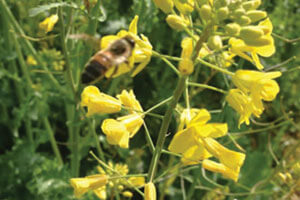COMMENT: Kale Honey

Attached are 2 pictures of my Kale field. This was somewhat of a mistake two years ago as I allowed some Kale to go to seed. The bloom time on this lasts about 3 weeks and peaks for about 10 days (pending weather). Frost seeding in mid to late October seems to work the best as the plants will germinate and grow 2-3 inches tall and then go dormant with the first hard freeze. They will be one of the first plants to become active in early march and bloom about 45-60 days later. The type of kale we used is called Siberian Dwarf. Our colonies are very close and when the nectar flow peaks, the Kale field becomes a bee hive in itself. Honey supers were filled very quickly and as you experienced, the taste is AWESOME.
Mike Wuerffel
Sugar Loaf Hill Farms, Illinois
Comment:
I met Mike at a meeting in Illinois and I was totally awed that he had made Kale (the stuff in your salad) honey. I had never heard of this. A picture is worth a 1000 Words. Very cool, and tasty.
Q
Good afternoon Mr. Jerry Hayes. I just went to pull honey off of my hives and I realized that it’s all honeydew. I’ve never experienced this problem. I know it’s no good to sell, but I really need to know if I should leave it on the hives to over winter my bees? I did some research, but I’m getting conflicting answers. Please help. Thank you so much for your time.
David DiBrango
A
Let’s explore this a bit David. Many plants and trees have a very small insect called an aphid or, plant lice in other parts of the world, that has piercing mouth parts and feed on the high sugar content liquid sap from phloem vessels in a plant. This sap in a plant is under pressure to move it up and around the plant. Once a phloem vessel is punctured, the sap under pressure is squirted into the aphid’s mouth and digestive system. Pretty cool actually. The aphid’s digestive system is almost a straight shot from mouth to anus as they need amino acids (proteins) just like you and I to live and have to process a lot of sap to get proper nutrition—a lot of sap! Much of the undigested sugary sap is excreted by the millions of aphids that might be feeding on tree onto leaf surfaces. And with the huge numbers of these destructive insects on a plant, a lot of sugary sap can be deposited on the leaf surfaces—enough that it becomes practical and economical for honey bees to collect it and store it as food for later as they would nectar converted to honey. Honeydew honey doesn’t meet the definition of honey that is made from flower nectar. So, it isn’t really honey, per definition, but this is a good product and has business dollar value.
A select group of beekeepers in Germany harvests Black Forest Honeydew ‘Honey’ that sells for a PREMIUM price. It is a unique product that has more demand than availability. Same situation in New Zealand for a unique Honeydew ‘Honey’ product. Some of it sells for as much as a US dollar or more per ounce. Remember, at the end of the day it is all about marketing and building awareness and value for your product. I would rethink your “it’s no good to sell” idea. It might be a lucrative niche market if you have enough and are a creative marketer.
I would not use it for winter feed as it has lots ‘indigestible’ material in it and if bees are confined in winter, wherever you are, it can facilitate honey bee dysentery. If you live where the bees can get out and defecate regularly in the winter, you are probably OK.
Q
Recently, I was given about two pounds of beeswax that was found in the bottom of an old solar wax melter of unknown origin. I would like to use this wax to coat plastic foundation before giving the foundation to the bees. I am aware that beeswax can retain a host of pesticides. My concern, however, is with American foulbrood, and whether foulbrood spores can survive in beeswax that has been heated to a liquid state. Simply, in reference to American foulbrood transmission, is it safe to use this beeswax to coat plastic foundation?
Once again, thank you for all the help you have provided.
Hal
Connecticut
A
Hello Hal. Think of the long-lasting ‘spores’ of American foulbrood (AFB) like a vegetable seed. When you plant the vegetable seed it has to be able to absorb water and interact with its environment under the ground to germinate and grow. Coat that vegetable seed in any kind of water proof wax and you have cut that seed off from the environment. It is isolated. It cannot germinate.
Any AFB spores have been coated the first time the wax melted in the solar wax melter. Now you are going to remelt…


